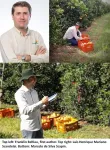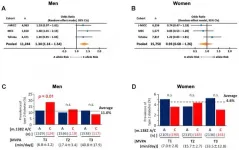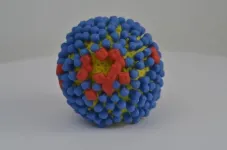(Press-News.org) Some of the most commonly used drugs for treating hereditary breast and ovarian cancers may not work the way we thought they did, according to new University of Colorado Boulder research.
The paper, published February 2 in the journal Nature Communications, sheds new light on how they do work and could open the door to new next-generation medications that work better, the authors said.
"Despite the success of these drugs which sell in the billions of dollars per year and treat many thousands of patients, there are many unknowns about their potency and efficacy that if better understood could lead to improvements," said senior author Karolin Luger, a professor in the Department of Biochemistry. "Our paper provides a fuller picture."
The research centers around a class of drugs known as PARP-inhibitors, broadly prescribed to target cancers fueled by a mutation in the BRCA, or BReast CAncer, gene.
When functioning properly, the BRCA gene plays a key role in repairing damaged DNA inside cells. When the gene is mutated or missing, cancer risk rises.
About one in 10 of the quarter-million women diagnosed with breast cancer annually have a BRCA mutation. And BRCA-fueled cancers tend to come earlier, be more aggressive, and resist treatment.
Enter PARP inhibitors.
First unveiled clinically in 2014, the drugs target a ubiquitous family of proteins called PARPs (poly-ADP-ribose), which were discovered in the 1960s and are also instrumental in fixing broken DNA.
"PARPs are the first responders," explains first author Johannes Rudolph, a senior researcher in the Department of Biochemistry who worked with graduate student Genevieve Roberts on the study. "DNA damage happens, PARP goes in and finds it, and then it sends out a signal to other proteins to come in and help with repairs."
Because both PARP and BRCA also serve to repair DNA damage inside cancer cells, disabling the PARP first-responder in someone who doesn't have a functioning BRCA repair crew delivers what Rudolph describes as a lethal "double whammy" to cancer cells.
With this in mind, pharmaceutical companies have raced to develop more PARP inhibitors, with at least four in use today and others being explored to treat different forms of cancer.
But as it turns out, PARP is not acting alone.
Scientists recently discovered that another protein called HPF1 (histone PARylation Factor 1) is attached to the PARP protein at precisely the location where all the action happens, working closely with it in its role as first responder.
Existing drugs were developed long before HPF1 was even known to exist.
So Rudolph and Luger began to wonder: Does this newly-discovered co-protein influence how well those cancer drugs work? And if so, could drugs designed specifically to target it also work better?
Their findings suggest yes.
"It appears that existing drugs were designed to inhibit only two-thirds of the proteins at play here, because we didn't know this other third existed," says Rudolph.
For the new paper, Rudolph developed a new method to study just how tightly existing drugs bind to PARP inside cells - a measure of potency and efficacy - both in the presence and absence of HPF1.
In some cases, the drugs worked just as well whether it was there or not. But in others, it made a big difference.
For instance, the drug Olaparib bound more tightly and significantly longer to PARP when HPF1 was present than when it was not.
Put simply, this drug may, by sheer coincidence, impact the combination of the two proteins, making it work better. Meanwhile, for other drugs, there is likely room for improvement.
"This suggests that future PARP inhibitors should be aimed at taking advantage of this interaction in order to become more potent," Rudolph said.
Luger notes that such room for improvement is likely there for many drugs currently on the market, as drug candidates are often tested in isolation in test tubes to see if they work, but once inside the cell they interact with a complex network of proteins and enzymes that are not entirely understood.
"Drug development tends to move quickly, moving from in-vitro models to animal models to clinical trials without fully understanding the mechanism of action," she says. "That's a fine approach because it gets you there fast, but if you really want to improve upon these drugs you need to understand why and how they really work. That's what we tried to do with this paper."
INFORMATION:
BUFFALO, N.Y. - A popular streaming service boasts a film inventory approaching 4,000 titles. When it's time to pick a movie, are you more likely to quickly make a decision or meticulously sift through the possibilities?
Psychologists refer to those who search minimally for something to arrive at an adequate choice as "satisficers." It's the "maximizers," meantime, who search exhaustively for what might be considered as the perfect option.
Previous studies exploring both strategies after making a choice often present satisficing as a more psychologically ...
An important bacterial disease that affects citrus trees and causes lesions, citrus canker has been effectively controlled by spraying copper. However standard management techniques involve spraying excessive amounts of copper and water without consideration for the size of the trees.
"This technique resulted in a waste of resources as well as higher costs, detrimental environmental impact, and risk for development of copper resistant strains," explained plant pathologist Franklin Behlau, who recently published an article discussing a more sustainable approach to managing citrus canker.
Behlau and his colleagues showed that it is possible to control citrus canker by spraying ...
The instrumental climate record is the cultural heritage of humankind, the result of the diligent work of many generations of people all over the world. However, the changes in the way in which temperature is measured, as well as the environment in which weather stations are located can produce spurious trends. An international study carried out by researchers from the Universitat Rovira i Virgili (URV), the State Meteorology Agency and the University of Bonn (Germany) have succeeded in identifying the most reliable methods that help correct these trends. These "homogenization methods" are a key step in converting the enormous effort made by observers into reliable data about climate change. The results of this research, funded by ...
The inauguration of Joe Biden and Kamala Harris marks a new era for science policy in the U.S. and beyond. The new administration has inherited a global pandemic and worsening climate change, among other science-related issues. A cover story in Chemical & Engineering News (C&EN), the weekly newsmagazine of the American Chemical Society, delves into what this means for chemists and chemistry as a whole.
One of the most pressing issues facing the Biden administration is the fight against climate change. Biden campaigned on net-zero emissions of greenhouse gases by 2050 and has laid out a sweeping plan to switch the U.S. to cleaner energy sources, which experts say ...
For decades, scientists have wrestled with rival theories to explain how interactions between species, like competition, influence biodiversity. Tracking microbial life across the planet, researchers from McGill University show that biodiversity does in fact foster further diversity in microbiomes that are initially less diverse. However, diversity rates plateau with increased competition for survival and space in more diverse microbiomes.
Published in eLife, the findings could help scientists better understand how microbiomes - communities of micro-organisms living together in particular habitats like humans, animals and plants or even soils and oceans ...
C polymorphism is associated with susceptibility to T2D in men, possibly interacting with exercise, and contributing to the risk of T2D in sedentary males by reducing the activity of MOTS-c.
Dr. Noriyuki Fuku from The Juntendo University and Dr. Pinchas Cohen from The University of Southern California said, "The prevalence of type 2 diabetes mellitus (T2D) is growing dramatically."
While diabetes syndromes directly caused by mutations in mtDNA are extremely rare, several genetic analyses reveal that mtDNA polymorphisms contribute to T2D risk in both European ...
Aging-US published "Screening of Alzheimer's disease by facial complexion using artificial intelligence" which reported that despite the increasing incidence and high morbidity associated with dementia, a simple, non-invasive, and inexpensive method of screening for dementia is yet to be discovered.
This study aimed to examine whether artificial intelligence could distinguish between the faces of people with cognitive impairment and those without dementia.
121 patients with cognitive impairment and 117 cognitively sound participants were recruited for the study.
The binary differentiation of dementia / non-dementia facial image was expressed as a "Face AI score".
However, MMSE score showed significantly stronger ...
Aging-US published "Sulforaphane promotes C. elegans longevity and healthspan via DAF- 16/DAF-2 insulin/IGF-1 signaling" which reported that the broccoli-derived isothiocyanate sulforaphane inhibits inflammation, oxidative stress and cancer, but its effect on healthspan and longevity are unclear.
The authors used the C. elegans nematode model and fed the wildtype and 9 mutant strains ±sulforaphane.
Sulforaphane increased the lifespan and promoted a health-related phenotype by increasing mobility, appetite and food intake and reducing lipofuscin accumulation.
Mechanistically, sulforaphane inhibited DAF-2-mediated insulin/insulin-like growth factor signaling and its downstream targets AGE-1, AKT-1/AKT-2. This was associated with increased nuclear translocation of ...
Amsterdam, NL, February 3, 2021 - Patients with Parkinson's disease (PD) and healthcare professionals caring for them have expressed concerns about the COVID-19 vaccine's efficacy and safety in the specific context of PD and its symptomatic treatment. In a END ...
WHAT:
An experimental single-dose, intranasal influenza vaccine was safe and produced a durable immune response when tested in a Phase 1 study published in the Journal of Clinical Investigation. The investigational vaccine, called Ad4-H5-VTN, is a recombinant, replicating adenovirus vaccine designed to spur antibodies to hemagglutinin, a protein found on the surface of influenza viruses that attaches to human cells.
The investigational vaccine was developed by Emergent Biosolutions Inc., (Gaithersburg, Maryland). It was administered intranasally (28 study participants), as an oral capsule (10 participants) and via a tonsillar swab (25 participants) to ...





